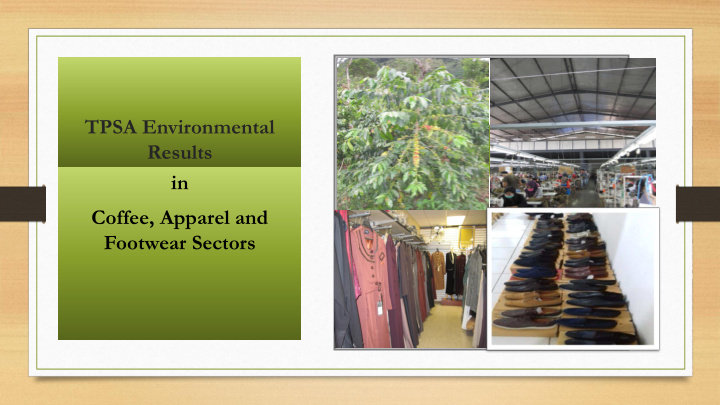



TPSA Environmental Results in Coffee, Apparel and Footwear Sectors
Environmental Objective 1 SMEs: Ensure TPSA project activities do not - Apparel cause detrimental environmental - Footwear impacts and, as much as possible, TPSA main enhance environmental benefits objective - Coffee Increased trade and investment between Canada and Indonesia Environmental Objective 2 Other Raise awareness of how stakeholders environmental sustainability affects international trade and investment
Environmental Enhancement Activities Coffee Training and monitoring were conducted in partnership with Indonesia Coffee and Cocoa Research Institute (ICCRI-Jember) Training of trainers Training of target SME and lead farmers on Monitoring Needs lead farmers in environmen environmentally assess- environmentally friendly tal progress friendly coffee ment coffee farming and farming & (Apr-May processing (Oct.2016) processing in Toraja 2018) (Jan 2018) and Gayo (Mar 2017) October 2016 – May 2018; three training sessions with 80 participants (lead farmers and agricultural extension officers) from Aceh and South Sulawesi
Sustainable Coffee Production and Processing Training Subjects Land preparation Seedlings, vegetative propagation techniques and planting Maintenance, pruning, weeding, etc. Pest and disease management Fertilizing /composting Post-harvest handling Processing and waste management Coffee farming and processing technologies Basic tasting/ coffee grading Field trip to Bondowoso organic coffee farming
Adopted techniques Results of technique application What techniques Faster compost making Healthier, more robust plants with have been adopted more yield Pruning techniques and how have they Vegetative propagation Good seedlings with preferred improved farmer techniques (e.g., cutting, characteristics (e.g., strong roots, grafting) good taste, high yield, etc.). coffee production? Reduced pest and disease occurrence. Pest and disease control Latest coffee Reduced labour technology/machinery Better coffee cherry quality Roasting techniques Better green bean quality Shade tree management Post-harvest handling
Some Examples of Adopted Practices Asman’s Dita coffee M. Salim showing nursery shows a the grown using young compost compost coffee she made from a plant learned mixture of propagated how to coffee pulp, from make livestock grafting at the manure, and two TPSA- EM. superior supporte coffee d training. varieties. A Teguh, Asman hypotan, his showing his an eco- father-in- newly friendly law, and bought soil coffee the TPSA drill. He borer team learned trap among about the installed the technology on newly and how to Mari pruned operate the Yani’s coffee drill during farm. trees. the training.
• Adoption of environmentally friendly coffee-farming techniques Recommendations is good for the environment and can also potentially improve coffee production and market access. • Teaching farmers sustainable agricultural practices has the potential to increase production without expanding coffee- growing areas, which could lead to further deforestation. • Farmers appear to feel secure producing environmentally friendly and sustainably certified coffee when the price and market are good and relatively stable. • Governments should consider linking Arabica coffee farmers with companies that focus on sustainable coffee.
Envir ironme mental ntal Enhanc ancem ement ent Activ ivit ities ies Appare arel l an and Foo ootwe twear ar SCORE program implementation: Sept.2017 – April 2018S Training 2: On-site consulting Resource Efficiency on Workplace Tring 1: & Cleaner On-site consulting on Collaboration & 5 S Production resource efficiency & Wainorkplace cleaner production Collaboration & 5 S Workshop Field trip to observe good introducing practices on cleaner SCORE-Cleaner production 12 SMEs received 2 in-class training sessions on Production workplace collaboration & cleaner production, 10 of which also received 6x one-on-one in-factory Workshop to report Needs assessment SME progress consulting. The 10 SMEs represent over 600 workers Training and technical assistance are based on ILO’s SCORE -(Sustaining Competitive and Responsible Enterprise) Resource Efficiency and Cleaner Production Program and were undertaken in partnership with ILO’s licensed Business Export Development Organization (BEDO-Bali). SCORE aims at improving SME’s working conditions and productivity through workplace cooperation and leaner and cleaner production.
Adopted practices How the practices contribute to cleaner production and efficiency Improved communication between 8 companies report that improved communication has How have management and employees helped avoid production mistakes and reduced adopted production-reject rates and waste by 4 to 20 per cent. practices Clean and decluttered working spaces 7 companies reported that their employees were more contributed to provide a healthier, safer, and more motivated as a result of the improved work pleasant work environment. environment. cleaner and more efficient The new sequential production layout 3 companies reported that the new layout increased production ? increased productivity production (ranging from 5 to 40 per cent) while using the same number of employees. The FIFO system promotes more efficient use of raw materials and avoids 9 companies applying the FIFO inventory system unnecessary waste and expired items. reported less time spent storing and finding supplies, thus increasing company efficiency. Reduced electricity use 4 companies reported reduced electricity use/unit of Reduced pollution product. 1 company reported reduced pollution. Reduced waste/ prolonging of by- 2 companies reported reduced waste/prolonging of products life cycles by-products life cycles.
Some Examples: Before and After Program Implementation Before Before After Before After After
Active involvement and support by company owners and senior management from the start of the program is critical to success. The owner’s business vision shapes the direction and extent of the company’s environmental improvements. Lessons Learned from Apparel and Footwear All 10 companies recognized the importance of improving communication and cooperation between management and employees. This is the foundation for SMEs environmental and other improvements. SMEs practising 5S have reduced wasted employee time and effort, excess inventory waste, and rejected-products waste. Resource-efficiency measures have helped to reduce production waste, pollution, and energy consumption. SMEs are more likely to implement cleaner-production measures when they can see the economic benefits (e.g., reduced costs, increased employee productivity). The SMEs noted that the one-on-one coaching and site visits were essential to their success. They appreciated that the program was not merely theoretical, but focused on concrete actions and change.
Thank You www.tpsaproject.com
Recommend
More recommend